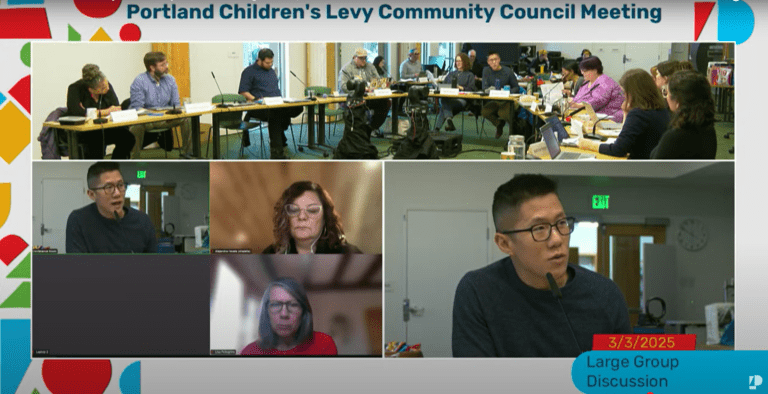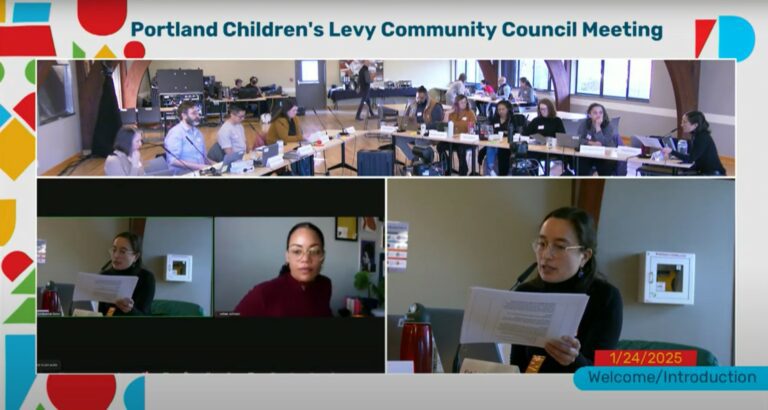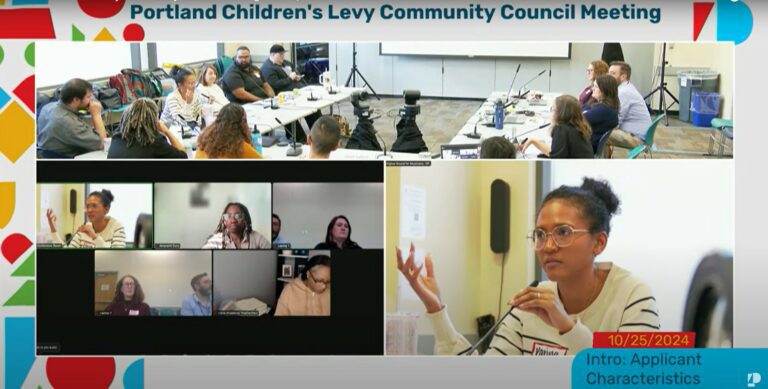Community Council Meeting Recap (5-29-24)
Welcome to the recap of the May 29, 2024 Community Council meeting. Eight out of 13 members were present during the meeting.
Meeting outcomes
- Discuss, change, and build consensus on 2024 large grants funding priorities for Allocation Committee consideration and decision in June.
- In the absence of consensus, provide staff with considerations to share with the Allocation Committee for their decision on grantmaking funding priorities.
Meeting summary
In advance of the meeting, PCL staff drafted funding priorities for each of the Levy’s six program areas, guided by the findings of the final community engagement report produced by Camille E. Trummer’s consulting team and presented during the May 6 joint Allocation Committee & Community Council meeting.
At the meeting, PCL staff facilitated a consensus building process to generate edits and additions to the funding priorities. Council members worked in small groups of two-three alongside two staff and reviewed and edited the funding priorities. Small groups also discussed a policy question related to the funding priorities posed by staff in each program area. After small group work, council members and staff transitioned to full Council consensus building on each program area’s funding priorities, moving through rounds of discussion to surface clarifying questions, edits and reactions, and must haves to support the funding priority. Council members completed two rounds of small group to full Council work, and by the end of the meeting reached consensus on funding priorities in all six program areas. Council members voted to recommend funding priorities in all six program areas, as edited and revised by the Community Council, to the Allocation Committee. What follows are the top edits and points of consideration from council members.
Funding priority feedback
Significant edits and additions to funding priorities are listed below. Smaller edits have not been included in this meeting summary but are reflected in the funding priorities. Please watch the meeting recording, specifically the full Council discussions, to hear all feedback. Video timestamps are included by each program area for ease of reference.
Feedback applicable to all funding priorities
- Include children with neurodivergence and developmental delays in all program services focusing on children with disabilities
- Standardize naming conventions of demographic groups across all funding priorities
- Use ‘African American/Black’ within the context of discussing ethnicity and race and referring to people of the African diaspora, do not use ‘Black’ alone
- Do not conflate a respondent’s language preference with their ethnic group(s)
- The use of ‘especially for’ language highlighting which demographic groups of community engagement participants prioritized specific services is confusing – rewrite and clarify that applicants are not required to serve those specific demographic groups in order to receive funding and that this information is meant to be additive and informative
Early childhood (start 1:30 – end 1:53)
- Add ‘offer community-based prenatal and postnatal maternal education’ to program services
- Add ‘system navigation for children and families to access basic needs (housing, utilities, food), health care, and/or other supportive services’ to program features
Foster care (start 1:54 – end 2:18)
- Add ‘mental health services’ to the reunification program service
- Add ‘culturally responsive practices’ to program features
After school (start 2:19 – end 2:40)
- ‘Southeast Asian’ and ‘English language learners’ need to be named in the priority communities for the academic supports program service
Child abuse prevention & intervention (start 3:08 – end 3:23)
- Add ‘access to substance use intervention and supports’ to the teen parent resources program service
Hunger relief (start 3:23 – end 3:34)
- Add ‘access to food grown and sold by people of the same culture as the family’ to program features
- Add ‘focused outreach to mothers for prenatal and postnatal nutrition support, education, and resources’ to program features
- Add ‘digital outreach and education methods’ to program features
- Add ‘access to a community kitchen or appliances’ to program features
Mentoring (start 3:34 – end 4:01)
- Add a program service that focuses on youth gang prevention and reduction
- Add ‘trauma-informed, culturally responsive strategies for prevention and reduction of gang involvement’ to program features


